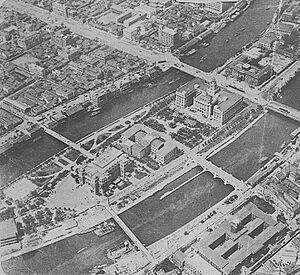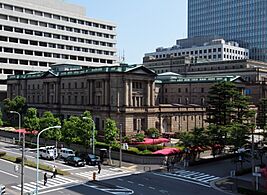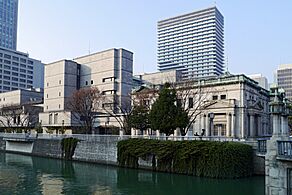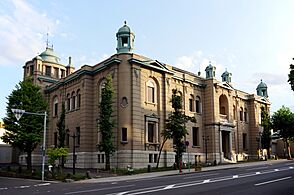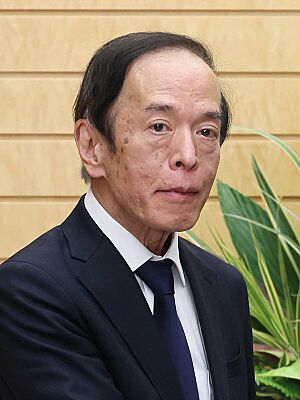Bank of Japan facts for kids
 |
|
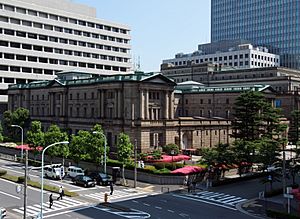
|
|
| Headquarters | Chūō, Tokyo, Japan |
|---|---|
| Coordinates | 35°41′10″N 139°46′17″E / 35.6861°N 139.7715°E |
| Established | 27 June/10 October 1882 |
| Governor | Kazuo Ueda (9 April 2023 – present) |
| Central bank of | |
| Currency | Japanese yen JPY (ISO 4217) |
| Reserves | US$ 1.12 trillion (October 2023) |
| Bank rate | +0.10% |
The Bank of Japan (日本銀行, Nippon Ginkō, BOJ, JASDAQ: 8301) is the central bank of Japan. The bank is often called Nichigin (日銀) for short. It is headquartered in Nihonbashi, Chūō, Tokyo.
The bank is a corporate entity independent of the Japanese government, and while it is not an administrative organisation of the state, its monetary policy falls within the scope of administration. From a macroeconomic perspective, long-term stability of prices is deemed crucial. However, the political sector tends to favour short-term measures. Thus, the bank's autonomy and independence are granted from the standpoint of ensuring long-term public welfare and political neutrality.
Contents
Overview
Objectives
The comprehensive revision of the Bank of Japan Act in 1998 clearly defined the objectives of the Bank of Japan as 'price stability' and 'financial system stability'. This revision affirmed the Bank's operation independent from the government (primarily the Ministry of Finance), and removed the provisions established in 1942, which had been problematic. The 1942 provision, enacted during the Second World War, stated the objective of the bank was to 'Ensure the Appropriate Exertion of the Nation's Total Economic Power, by Regulating Currency, Adjusting Finance, and Maintaining and Fostering the Credit System in Accordance with the Policies of the State (国家経済総力ノ適切ナル発揮ヲ図ル為国家ノ政策ニ即シ通貨ノ調節、金融ノ調整及信用制度ノ保持育成ニ任ズル。)'.
BoJ's policies are decided at Monetary Policy Meetings (MPM, Kinyu Seisaku Kettei Kaigo, 金融政策決定会合), which are attended by the Policy Board and held every other month.
Price stability
Stable prices are maintained by seeking to ensure that price increases meet the inflation target. The bank aims to meet this target primarily by adjusting the base interest rate (known as the bank rate), which is decided by the Policy Board.
As of 2024 the inflation target is 2%. Japan has long suffered deflation and disinflation since the 1990s, which has been blamed as one of the main causes of the long-term economic downturn of the once world's second largest economy. For the past two decades, the primary focus of BOJ policies has been to achieve a stable inflation.
Financial system stability
Financial system is defined as the overall structure of receipt and payment as well as lending and borrowing of money, and its stability refers to 'a state in which the financial system functions properly, and participants, such as firms and individuals, have confidence in the system'.
Functions
The aforementioned objectives are realised through the exertion of the functions mentioned below.
- As the sole issuer of banknotes of Japan, BoJ carries out the issuance and management of Bank of Japan notes.
- BoJ implements monetary policy through methods such as policy interest rate (formerly known as the official discount rate) operations, open market operations, and reserve requirement ratio operations, thereby adjusting the volume of money in circulation to stabilise prices and the national economy.
- BoJ facilitates transactions among financial institutions using its current accounts, effectively acting as a 'bank for banks'. (Individuals and corporations (such as general businesses) are not allowed to open accounts with BoJ.)
- BoJ serves as the government's bank for the disbursement and receipt of public funds.
- As a 'bank of banks', BoJ ensures the stability of the financial order through smooth fund settlements via domestic exchange transactions and providing system collateral (acting as the "lender of last resort") through facilities such as BoJ's special lending programme (Nichigin Tokuyu, 日銀特融). Transactions in deposits and loans are restricted to financial institutions designated in accordance with the Bank of Japan Act.
- BoJ conducts international relations activities, including interventions in the foreign exchange market, with other central banks and public institutions worldwide.
- BoJ collects and researches financial and economic information, and compiles and publishes economic statistics.
The trail of policies
When the Nixon shock happened in August 1971, the Bank of Japan (BOJ) could have appreciated the currency in order to avoid inflation. However, they still kept the fixed exchange rate as 360Yen/$ for two weeks, so it caused excess liquidity. In addition, they persisted with the Smithsonian rate (308Yen/$), and continued monetary easing until 1973. This created a greater-than-10% inflation rate at that time. In order to control stagflation, they raised the official bank rate from 7% to 9% and skyrocketing prices gradually ended in 1978.
In 1979, when the energy crisis happened, the BOJ raised the official bank rate rapidly. The BOJ succeeded in a quick economic recovery. After overcoming the crisis, they reduced the official bank rate. In 1980, the BOJ reduced the official bank rate from 9.0% to 8.25% in August, to 7.25% in November, and to 5.5% in December in 1981. "Reaganomics" was in vogue in America and USD became strong. However, Japan tried to implement fiscal reconstruction at that time, so they did not stop their financial regulation.
In 1985, the agreement of G5 nations, known as the Plaza Accord, USD slipped down and Yen/USD changed from 240yen/$ to 200yen/$ at the end of 1985. Even in 1986, USD continued to fall and reached 160yen/$. In order to escape deflation, the BOJ cut the official bank rate from 5% to 4.5% in January, to 4.0% in March, to 3.5% in April, 3.0% in November. At the same time, the government tried to raise demand in Japan in 1985, and did economy policy in 1986. However, the market was confused about the rapid fall of USD. After the Louvre Accord in February 1987, the BOJ decreased the official bank rate from 3% to 2.5%, but JPY/USD was 140yen/$ at that time and reached 125yen/$ in the end of 1987. The BOJ kept the official bank rate at 2.5% until May in 1989. Financial and fiscal regulation led to a widespread over-valuing of real estate and investments and Japan faced a bubble at that time.
After 1990, the stock market and real asset market fell. At that time BOJ regulated markets until 1991 in order to end the bubble.
In January 1995, a terrible earthquake happened and Japanese yen became stronger and stronger. JPY/USD reached 80yen/$, so the BOJ reduced the office bank rate to 0.5% and the yen recovered. The period of deflation started at that time.
In 1999, the BOJ started zero-interest-rate policy (ZIRP), but they ended it despite government opposition when the IT bubble happened in 2000. However, Japan's economic bubble burst in 2001 and the BOJ adopted the balance of current account as the main operating target for the adjustment of the financial market in March 2001 (quantitative relaxation policy), shifting from the zero-interest-rate policy. From 2003 to 2004, Japanese government did exchange intervention operation in huge amount, and the economy recovered a lot. In March 2006, BOJ finished quantitative easing, and finished the zero-interest-rate policy in June and raised to 0.25%.
In 2008, the financial crisis happened, and Japanese economy turned bad again. BOJ reduced the uncollateralized call rate to 0.3% and adopted the supplemental balance of current account policy. In December 2008, BOJ reduced uncollateralized call rate again to 0.1% and they started to buy Japanese Government Bond (JGB) along with commercial paper (CP) and corporate bonds.
In 2013, the head of the BOJ (Kuroda) announced a new quantitative easing program (QE). This program would be very large in terms of quantity, but it would also be different in terms of quality—qualitative easing (QQE). In other words, the BOJ would (and did) also purchase riskier assets like stocks and REITs. In 2016, the BOJ initiated yield curve control (YCC), and started its negative interest rates policy (NIRP). The BOJ is also the largest owner of Japanese stocks. In 2024, following announcements of about 5% wage growth by Japan's largest companies, the BOJ ended eight year of negative interest rates by setting new short term targets of 0 to 0.1%.
Curbing deflation
Following the election of Prime Minister Shinzō Abe in December 2012, the Bank of Japan, with Abe's urging, took proactive steps to curb deflation in Japan. On 30 October 2012, The Bank of Japan announced that it would undertake further monetary-easing action for the second time in a month. Under the leadership of new Governor Haruhiko Kuroda, the Bank of Japan released a statement on 5 April 2013 announcing that it would be purchasing securities and bonds at a rate of 60-70 trillion yen a year in an attempt to double Japan's money base in two years. But by 2016, it was apparent that three years of monetary easing had had little effect on deflation so the Bank of Japan instigated a review of its monetary stimulus program.
History
Like most modern Japanese institutions, the Bank of Japan was founded after the Meiji Restoration. Prior to the Restoration, Japan's feudal fiefs all issued their own money, hansatsu, in an array of incompatible denominations, but the New Currency Act of Meiji 4 (1871) did away with these and established the yen as the new decimal currency, which had parity with the Mexican silver dollar. The former han (fiefs) became prefectures and their mints became private chartered banks which, however, initially retained the right to print money. For a time both the central government and these so-called "national" banks issued money. A period of unanticipated consequences was ended when the Bank of Japan was founded in Meiji 15 (10 October 1882), under the Bank of Japan Act 1882 (27 June 1882), after a Belgian model. It has since been partly privately owned (its stock is traded over the counter, hence the stock number). A number of modifications based on other national banks were encompassed within the regulations under which the bank was founded. The institution was given a monopoly on controlling the money supply in 1884, but it would be another 20 years before the previously issued notes were retired.
Following the passage of the Convertible Bank Note Regulations (May 1884), the Bank of Japan issued its first banknotes in 1885 (Meiji 18). Despite some small glitches—for example, it turned out that the konjac powder mixed in the paper to prevent counterfeiting made the bills a delicacy for rats—the run was largely successful. In 1897, Japan joined the gold standard, and in 1899 the former "national" banknotes were formally phased out.
Since its Meiji era beginnings, the Bank of Japan has operated continuously from main offices in Tokyo and Osaka.
Reorganization
The Bank of Japan was reorganized in 1942 (fully only after 1 May 1942), under the Bank of Japan Act of 1942 (日本銀行法 昭和17年法律第67号), promulgated on 24 February 1942. There was a brief post-war period during the Occupation of Japan when the bank's functions were suspended, and military currency was issued. In 1949, the bank was again restructured.
In the 1970s, the bank's operating environment evolved along with the transition from a fixed foreign currency exchange rate and a rather closed economy to a large open economy with a variable exchange rate.
During the entire post-war era, until at least 1991, the Bank of Japan's monetary policy has primarily been conducted via its 'window guidance' (窓口指導) credit controls (which are the model for the Chinese central bank's primary tool of monetary policy implementation), whereby the central bank would impose bank credit growth quotas on the commercial banks. The tool was instrumental in the creation of the 'bubble economy' of the 1980s. It was implemented by the Bank of Japan's then "Business Department" (営業局), which was headed during the "bubble years" from 1986 to 1989 by Toshihiko Fukui (who became deputy governor in the 1990s and governor in 2003).
A major 1997 revision of the Bank of Japan Act was designed to give it greater independence; however, the Bank of Japan has been criticized for already possessing excessive independence and lacking in accountability before this law was promulgated. A certain degree of dependence might be said to be enshrined in the new Law, article 4 of which states:
- In recognition of the fact that currency and monetary control is a component of overall economic policy, the Bank of Japan shall always maintain close contact with the government and exchange views sufficiently, so that its currency and monetary control and the basic stance of the government's economic policy shall be mutually harmonious.
However, since the introduction of the new law, the Bank of Japan has rebuffed government requests to stimulate the economy.
Location
The Bank of Japan is headquartered in Nihonbashi, Chūō, Tokyo, on the site of a former gold mint (the Kinza) and, not coincidentally, near the famous Ginza district, whose name means "silver mint". The Neo-baroque Bank of Japan building in Tokyo was designed by Tatsuno Kingo in 1896.
The Osaka branch in Nakanoshima is sometimes considered as the structure which effectively symbolizes the bank as an institution.
- Bank of Japan
-
The Bank of Japan Otaru Museum in Otaru, Hokkaido
Governor
| Governor of the Bank of Japan | |
|---|---|
| Style | His Excellency |
| Appointer | The Prime Minister |
| Term length | Five years |
| Inaugural holder | Yoshihara Shigetoshi |
| Formation | 6 October 1882 |
The governor of the Bank of Japan (総裁, sōsai) has considerable influence on the economic policy of the Japanese government.
List of governors
| # | Governor | Took office | Left office | Previous jobs | Alma Mater |
|---|---|---|---|---|---|
| 1 | Yoshihara Shigetoshi | 6 October 1882 | 19 December 1887 | bureaucrat, diplomat | Yale University |
| 2 | Tomita Tetsunosuke | 21 February 1888 | 3 September 1889 | bureaucrat, diplomat | Whitney Business College, Newark |
| 3 | Kawada Koichiro | 3 September 1889 | 7 November 1896 | Senior member of Mitsubishi | |
| 4 | Iwasaki Yanosuke | 11 November 1896 | 20 October 1898 | Head of Mitsubishi | Edward Hall's Family School for Boys |
| 5 | Tatsuo Yamamoto | 20 October 1898 | 19 October 1903 | central banker | Mitsubishi School of Commerce |
| 6 | Shigeyoshi Matsuo | 20 October 1903 | 1 June 1911 | bureaucrat | |
| 7 | Korekiyo Takahashi | 1 June 1911 | 20 February 1913 | bureaucrat | Meiji Gakuin |
| 8 | Yatarō Mishima | 28 February 1913 | 7 March 1919 | banker | University of Massachusetts Amherst |
| 9 | Junnosuke Inoue (First) | 13 March 1919 | 2 September 1923 | central banker | University of Tokyo |
| 10 | Otohiko Ichiki | 5 September 1923 | 10 May 1927 | bureaucrat
(Ministry of Finance) |
University of Tokyo |
| 11 | Junnosuke Inoue (Second) | 10 May 1927 | 12 June 1928 | ||
| 12 | Hisaakira Hijikata | 12 June 1928 | 4 June 1935 | central banker | University of Tokyo |
| 13 | Eigo Fukai | 4 June 1935 | 9 February 1937 | businessman
central banker |
Doshisha |
| 14 | Seihin Ikeda | 9 February 1937 | 27 July 1937 | Head of Mitsui | Keio Gijuku |
| 15 | Toyotaro Yuki | 27 July 1937 | 18 March 1944 | central banker | University of Tokyo |
| 16 | Keizo Shibusawa | 18 March 1944 | 9 October 1945 | banker | University of Tokyo |
| 17 | Eikichi Araki (First) | 9 October 1945 | 1 June 1946 | central banker | University of Tokyo |
| 18 | Hisato Ichimada | 1 June 1946 | 10 December 1954 | bureaucrat
(Ministry of Finance) |
University of Tokyo |
| 19 | Eikichi Araki (Second) | 11 December 1954 | 30 November 1956 | ||
| 20 | Masamichi Yamagiwa | 30 November 1956 | 17 December 1964 | bureaucrat
(Ministry of Finance) |
University of Tokyo |
| 21 | Makoto Usami | 17 December 1964 | 16 December 1969 | banker (Mitsubishi bank) | Keio University |
| 22 | Tadashi Sasaki | 17 December 1969 | 16 December 1974 | central banker | University of Tokyo |
| 23 | Teiichiro Morinaga | 17 December 1974 | 16 December 1979 | bureaucrat
(Ministry of Finance) |
University of Tokyo |
| 24 | Haruo Maekawa | 17 December 1979 | 16 December 1984 | central banker | University of Tokyo |
| 25 | Satoshi Sumita | 17 December 1984 | 16 December 1989 | bureaucrat
(Ministry of Finance) |
University of Tokyo |
| 26 | Yasushi Mieno | 17 December 1989 | 16 December 1994 | central banker | University of Tokyo |
| 27 | Yasuo Matsushita | 17 December 1994 | 20 March 1998 | bureaucrat
(Ministry of Finance) |
University of Tokyo |
| 28 | Masaru Hayami | 20 March 1998 | 19 March 2003 | central banker | Hitotsubashi University |
| 29 | Toshihiko Fukui | 20 March 2003 | 19 March 2008 | central banker | University of Tokyo |
| 30 | Masaaki Shirakawa | 9 April 2008 | 19 March 2013 | central banker | University of Tokyo (B.A.)
University of Chicago (M.A.) |
| 31 | Haruhiko Kuroda | 20 March 2013 | 9 April 2023 | bureaucrat
(Ministry of Finance) President of ADB |
University of Tokyo (B.A.)
University of Oxford (MPhil) |
| 32 | Kazuo Ueda | 9 April 2023 | Incumbent | Economist at the University of Tokyo | University of Tokyo (B.S., B.A.) |
Monetary Policy Board
As of 9 April 2023, the board responsible for setting monetary policy consisted of the following 9 members:
- Kazuo Ueda, Governor of the BOJ
- Uchida Shinichi, Deputy Governor of the BOJ
- Himino Ryozo, Deputy Governor of the BOJ
- Adachi Seiji
- Nakamura Toyoaki
- Noguchi Asahi
- Nakagawa Junko
- Takata Hajime
- Tamura Naoki
Subsidiaries and properties
Bank of Japan owns 4.7% of the Tokyo Stock Exchange. Since 2020 it has owned more of the market than any other body.
See also
 In Spanish: Banco de Japón para niños
In Spanish: Banco de Japón para niños
- Japanese yen
- Economy of Japan
- Japan Mint
- List of central banks


